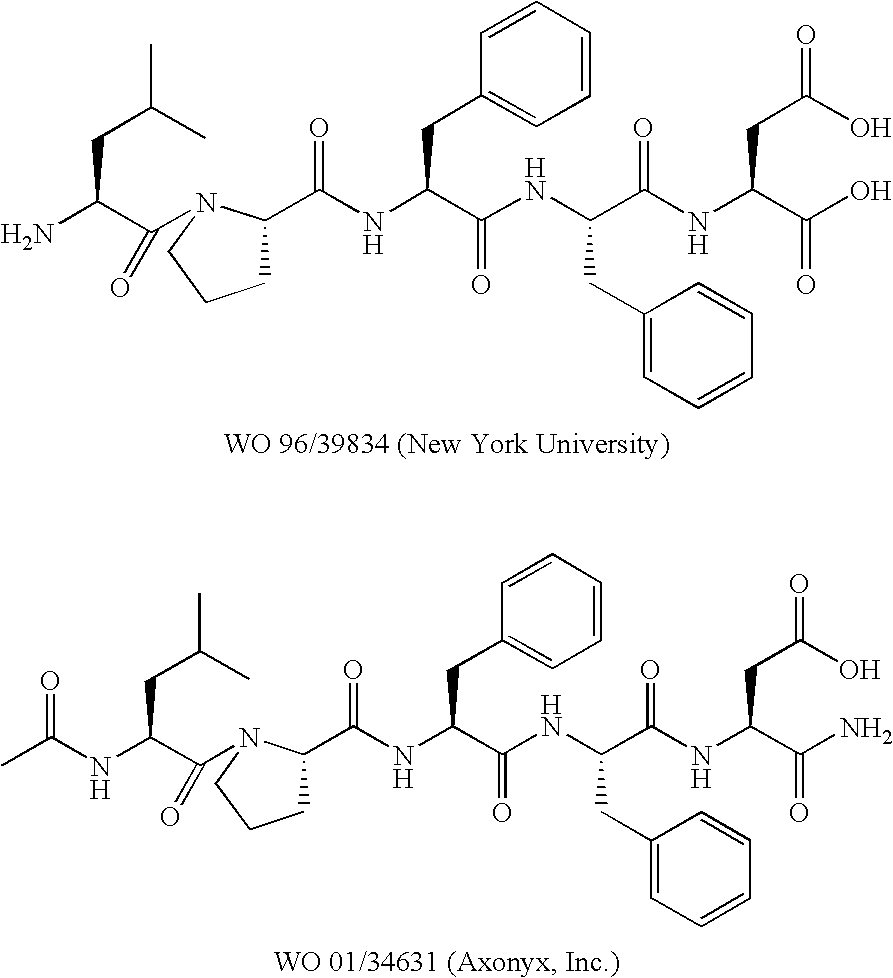Aza-peptides
a technology of aza-peptides and aza-peptides, which is applied in the direction of peptides, drug compositions, peptide/protein ingredients, etc., can solve the problems of high societal cost of managing ad, and no treatment that significantly retards the progression of the disease, so as to improve the pharmacological profile
- Summary
- Abstract
- Description
- Claims
- Application Information
AI Technical Summary
Benefits of technology
Problems solved by technology
Method used
Image
Examples
example 1
Building Block: N′-(4-Nitrobenzyloxy-carbonyl)-N2-benzyl-hydrazine (1)
[0132] Compound of example 1 is compound of Formula (III) wherein R is H and can be synthesized following schemes 4-5:
1) N1-(4-Nitrobenzyloxy-carbonyl)-N2-(tert.butyloxy-carbonyl)-hydrazine (1a)
[0133]
[0134] 1.23 g (9.28 mmol) of tert-butyl-carbazate and 3.2 ml (15.55 mmol) of dipea were dissolved in 50 ml of DCM. To this solution was added dropwise a solution of 2 g (9.28 mmol) of 4-nitrobenzyl chloroformate in 50 ml of DCM.
[0135] The mixture was magnetically stirred for 1 hour. The solution was washed with HCl 0.1 N, the organic phase was dried with magnesium sulfate and concentrated under vacuum affording a yellowish solid which leads to compound 1a (2.45 g, 86%.yield). LC-MS; (M-Boc+1)+=212; (M−1)−=310.2. 1H-NMR: (CDCl3, 300 Mz), δ: 1.47 (s, 9H,); 5.32 (s, 2H); 6.45 (bs, 1H,) 6.82 (bs, 1H); 7.02 (d, 2H), 8.23 (d, 2H). 13C-NMR: (CDCl3, 300 Mz) δ: 28.50; 66.46; 82.505; 121.16; 128.56; 143.41; 148.10; 154.00; ...
example 2
Building Block: Pyrazolidine-1-carboxylic acid-(4-nitrobenzyl)ester (2)
[0140] Compound of example 2 is compound of Formula (VI) or of Formula (VII′″) wherein Prot1 is 4-NO2-Cbz and can be synthesized following scheme 6:
1) N1-tert.butyloxy-carbonyl-N2-benzyloxy-carbonyl-hydrazine (2a)
[0141]
[0142] 10 g of commercially available tert-butyl-carbazate were dissolved in 400 ml of DCM, to which was added dropwise a solution of 25.9 ml of DIPEA in 100 ml of DCM, followed by the addition of a solution of 11.88 ml of benzyloxycarbonyl-chloride in 100 ml of DCM. This mixture was magnetically stirred overnight. After that the solution was washed with HCl 0.1 N. and with brine. The organic phase was dried with magnesium sulfate and concentrated under vacuum, affording a yellow oil (2a) (20.2 g, 99%). LC-MS; (M−1)−=265.22. 1H-NMR: (DMSO, 300 Mz) δ: 1.48 (s, 9H,); 5.19 (s, 2H); 6.39 (bs, 1H,) 6.63 (bs, 1H); 7.37 (m, 5H). 13CNMR: (DMSO, 300 Mz) δ: 28.51; 68.156; 82.24; 128.94; 136.00; 158.40.
2)...
example 3
Building Block: N1-(4-Nitrobenzyloxy-carbonyl)-N2-isobutyl-hydrazine (3)
[0152] Compound of example 3 is compound of Formula (IV) wherein R is H and can be synthesized following schemes 4-5 as described above for compound (1).
PUM
| Property | Measurement | Unit |
|---|---|---|
| pressure | aaaaa | aaaaa |
| time | aaaaa | aaaaa |
| concentrations | aaaaa | aaaaa |
Abstract
Description
Claims
Application Information
 Login to View More
Login to View More - R&D
- Intellectual Property
- Life Sciences
- Materials
- Tech Scout
- Unparalleled Data Quality
- Higher Quality Content
- 60% Fewer Hallucinations
Browse by: Latest US Patents, China's latest patents, Technical Efficacy Thesaurus, Application Domain, Technology Topic, Popular Technical Reports.
© 2025 PatSnap. All rights reserved.Legal|Privacy policy|Modern Slavery Act Transparency Statement|Sitemap|About US| Contact US: help@patsnap.com



